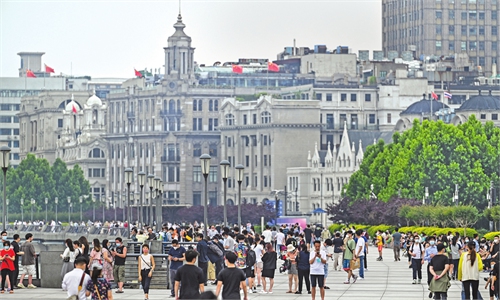
Workers are busy at the factory of Zhuolang Intelligent Machinery Co., Ltd. in Urumqi, northwest China's Xinjiang Uygur Autonomous Region, Oct. 22, 2020.(Photo: Xinhua)
China's May industrial production expanded 0.7 percent year-on-year, while fixed-asset investment up 6.2 percent in the first five months, indicating strong signs of rebound and resilience of the world's second-largest economy after Omicron flare-ups dealt a heavier-than-expected blow to major economic activities last month.
Industrial production expanded 0.7 percent year-on-year in May, compared with contraction of 2.9 percent year-on-year in the previous month, data from the National Bureau of Statistics (NBS) showed on Wednesday.
From January to May, the country's fixed-asset investment rose by 6.2 percent year-on-year, beating market expectations of 6 percent.
Retail sales, a main gauge of consumption, contracted 6.7 percent in May, better than 11.1 percent fall in April, according to the NBS.
"With the gradual stabilization of the economy through epidemic control and policy implementation, companies and factories have been accelerating resumption, resulting in apparent manufacturing improvement in pandemic-hit regions, including the Yangtze River Delta and Northeast China," Fu Linghui, a spokesperson from the National Statistics of Bureau, said at a press briefing on Wednesday.
In May, the industrial output of above-scale enterprises in the two regions fell 3.2 percent and 1.1 percent year-on-year, respectively, narrowing by more than 10 percentage points compared with April.
"The remarkable improvement in macro-economic indexes is an encouraging signal that China's economy has embarked on a faster-than-expected track of recovery," Tian Yun, former vice director of the Beijing Economic Operation Association, told the Global Times on Wednesday.
The fast rollout of support policies in late May had an impact on the May data, Li Changan, a professor at the Academy of China Open Economy Studies of the University of International Business and Economics, told the Global Times.
Special-purpose bonds further drove up investment in May, while industrial output recovered faster in the month, compared with that in April, Li said.
China reported sharp drops in retail sales and industrial production in April - far worse than analysts had expected - as Omicron outbreaks hit the capital city Beijing and the financial center Shanghai, along with nearby Jiangsu and Zhejiang provinces.
Fully aware of the situation, since late April, central government meetings, primarily focusing on stabilizing growth and market entities and ensuring employment, have been held to shore up the economy.
On May 25, the State Council, China's cabinet, held a keenly watched national teleconference on stabilizing the economy with reportedly upward of 100,000 participants, demonstrating the government's unparalleled resolve to bolster conditions.
Moreover, targeted policies from tax cuts to consumption vouchers and support policies for market entities have been announced by central and local authorities, which analysts said had effectively and promptly shored up market confidence and stabilized prospects.
While effectively carrying out pandemic control, the authorities will make timely policy adjustments to boost the implementation of the of announced policies for the sustainability of domestic economy, according to Fu.
Observers said the slew of favorable figures may signal that the worst may be over, while also paving the way for China to achieve its second-quarter growth target despite uncertainties both at home and abroad may pose headwinds.
Second-quarter growth could still reach 5 percent, with accelerated efforts landing on the ground in June, inspectors from the central government overseeing their implementation, and local governments working on them, Li said, noting that from the current outlook, the epidemic probably had only a partial impact on the economy in June.
With strong political will, the Chinese economy still stands a chance to leap for the stated target of around 5.5 percent annual growth, Li said.
China's GDP grew by 4.8 percent in the first quarter of 2022.
Figures measuring manufacturing activity, goods trade and credit growth also point to a brighter-than-expected economic landscape. For instance, the country's exports in US dollar terms gained 16.9 percent year-on-year in May, more than double the market consensus of a jump of less than 8 percent, according to customs figures.
This compared with a 3.9 percent increase in exports for April, a sharp fall from a 14.7 percent gain for March.

